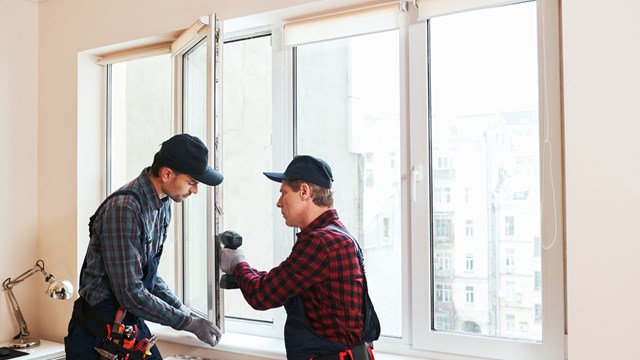
Any building in New Jersey that is taller than, say, five stories usually has an elevator—and often, new buildings of even three stories have an elevator. If you live in a high rise co-op or condo building on Palisade Avenue in Fort Lee, chances are that you use an elevator every day.
Chances are also that you don’t give much thought to it, and when you look at the inspection report posted inside the elevator cab, you don’t spend much time analyzing it. Yet, elevators are essential to any mid-rise or high-rise apartment building. See how upset people are when their elevator is out of service for even a few hours!
In the Beginning
There have been elevator-like hoist devices throughout history, but in 1853, American inventor Elisha Otis invented a freight elevator equipped with a safety device to prevent the elevator from falling in case a cable broke. This advancement paved the way for elevators to become commonplace in commercial and then residential buildings.
While the first passenger elevator was installed in a New York City department store, the first passenger elevator for residential buildings came into general use around 1877. But before World War I, elevators were still fairly rare and confined to upscale apartment houses, prestigious office buildings and fancy department stores. Many of the elevators of that period resembled luxurious drawing rooms, with small couches, wood paneling and uniformed operators.
Computer-Aided Design
Today, we see two basic types of elevators—hydraulic and “rope-driven.” One far-reaching change in the elevator industry, as in all industries, has been computerization. Whereas elevators 40 years ago or so were either controlled by relays or by an older type of solid-state controls, according to Brian Black, code and safety consultant for National Elevator Industry Inc., they are almost all computerized nowadays. That said, according to Black, “most elevators of any age are not obsolete. You can modernize systems; modernize old relay systems with a computer. Many elevators are being modernized on a regular basis. There’s no reason any elevator should be obsolete.”
Some of the most recent elevator design improvements are safety-based. One example is a device called a rope gripper—if an elevator should move on its own (because of an error), the rope gripper will sense this and grip the cable, preventing it from moving further. And in general, in newer solid-state elevators, the car won’t move unless all the circuits are operating and all the doors are closed.
Oversight and Inspection
In New Jersey, the Elevator Safety Unit in the Department of Community Affairs (DCA) is in charge of ensuring that elevators and escalators throughout the Garden State remain the safest mode of transportation. The Elevator Safety unit registers all elevator devices in the state, according to DCA spokeswoman Lisa Ryan. Elevator devices consist of elevators (hydraulic, traction, winding drum, roped hydraulic, rack & pinion and limited use limited access), escalators, moving walks, dumbwaiters, wheel chair lifts, chair lifts and man lifts. The elevator subcode is regulated under the Uniform Construction Code in Subchapter 12.
Ryan adds that this unit enforces the subcode and inspects elevators in state buildings and municipalities under the jurisdiction of the DCA’s Office of Local Code Enforcement. Municipalities give jurisdiction to enforce the Elevator Subcode to the DCA’s Elevator Safety Unit.
“In New Jersey, the elevator codes are governed by the Department of Community Affairs: The Elevator Safety Unit,” notes TinaMarie Cortina, marketing director for Liberty Elevator Corporation in Paterson. “If there is not a state employee designated to a certain town in New Jersey, then the town will appoint a department or hire a third party company to handle the elevator inspections that abide by the state mandated codes.”
For example, if the state has jurisdiction, the Elevator Safety unit coordinates inspections between the owner, elevator company and the state. The unit conducts all cyclical and acceptance (inspections under permit) inspections. Owners are then billed for inspections directly by the state.
According to Chris Robinson, president of Robinson Elevator in Middlesex, New Jersey, the “elevator codes are governed by the American Society of Mechanical Engineers “Safety Code for Elevators and Escalators” ASME A17.1-2007 for New Jersey.” He notes that each township or municipality having jurisdiction, may have additional requirements along with ASME A17.1.
What exactly is in the code? Building codes are complicated, but Ryan says that many of the administrative requirements haven’t changed in years. Some are pretty basic: a permit is required to install a new elevator as well as to perform work (rather than ordinary maintenance) on an existing elevator; newly installed elevators must be registered with the state; existing elevators are subject to cyclical maintenance inspection and tests must be performed by inspectors licensed by the state. When subcontractors are used, these privately-employed certified elevator personnel perform the required annual inspections, tests, and maintenance.
Licensing
Cortina says that training requirements for elevator personnel have just changed. Up until December 7, 2012, “no formal certificate or education was required in New Jersey to work on an elevator.” Governor Chris Christie though just recently signed into law the Elevator Safety Bill (S612) to license elevator, escalator and moving sidewalk contractors, although its enforcement is pending, she says.
Provisions of the bill call for a seven-member oversight board to be appointed consisting of an elevator business representative, one manufacturer, one member of the executive branch of state government, one architectural design representative, one member of the labor union representing elevator contractors, and two members of the public. This board, according to the bill, will be established for the purpose of “granting licenses to those persons engaged in the business of installing, constructing, altering, servicing, repairing, testing or maintaining elevator devices.” The board will also create standards for professional development and education. The cost of establishing the board will be offset by the new licensing revenue. The licensing exam will be uniform but can be waived under certain conditions, according to the legislation.
Up to Speed
It’s basically the responsibility of the building owner or manager (or, in the case of a condo or co-op, the board) to keep up to speed on these codes, new developments, and inspections, notes Black. So what is a good elevator maintenance inspection schedule—both as mandated by law, and as recommended by industry experts?
Robinson says that for elevators, periodic inspections occur every 6 months; a Category 1 test occurs yearly; and a Category 5 occurs every 5 years. The same would apply for hydraulic elevators except for the 5-year test. A 5-year test is only required for a roped hydraulic elevator. An outline of what is covered in each of these inspections can be found in Section 8.11.1 – 8.11.5.13 of ASME A17.1 – 2007, he says.
Cortina concurs on the existence of semi-annual, annual and five-year tests. “All elevators,” she says, “require a semi-annual visual inspection by the inspector only. Hydraulic elevators require annual tests. This consists of a no-load pressure test requiring the inspector and a trained elevator mechanic to be present. Other aspects of elevator operation and safety are tested at this time as well. Traction elevators and roped hydraulic elevators also require an annual elevator inspection however they are also subject to five year tests. During these five year tests, a full load test occurs which requires the inspector and two elevator mechanics to test 125% of the gross load of the elevator when testing safety devices. Additionally, operational functions and safety devices are checked.”
Testing of elevators usually involves operation of an elevator’s emergency braking system, verification of its speed regulation systems, or verification of the elevator’s pressurized vessel integrity, as well as many other safety features often unseen by the riding public.
Maintenance, Robinson says, depends on a number of factors. “This will depend on the type of equipment being serviced, frequency of usage, speed, duty, number of stops. Hydraulic elevators require less maintenance visits compared to mid-rise or high rise buildings with multiple higher speed equipment,” he says.
Here is what a typical schedule will entail, says Robinson. Hydraulic elevators require monthly visits; low-rise office or commercial buildings require bi-monthly visits; and high-rise buildings (more than 10 floors) require weekly visits. At each visit, the mechanic should check in with the appropriate person in charge of the elevators to see if there are any issues that need immediate attention. Routine maintenance, he says, involves many different areas of the elevator installation. For example, that maintenance would cover equipment in the elevator machine room, equipment in the hoistway and car top and equipment located in the pit of the elevator.
Costs of maintenance contracts vary due to type of coverage, and the type of equipment, he says.
Michael Halpin, organizer for Local 1, International Union of Elevator Constructors, New York and New Jersey, adds that a good schedule does include monthly maintenance as well as annual inspections. Even when maintenance is not in a particular municipal code, he says, “it’s highly recommended.”
Look carefully at what’s in the contract, says Cortina. Two common contracts, she says, include full maintenance and examination and lubrication agreements. Full maintenance agreements typically include parts and labor during normal business hours, whereas examination and lubrication (E&L) typically consists of a less frequent maintenance schedule where just labor is included. Full maintenance agreements typically have monthly service visits or routine and systematic visits; E&L visits tend to be less frequent, on a quarterly or semi-annual basis.
Testing, Testing?
Black further describes what tests can reveal. “They will show if there are suddenly unintended car movements, whether the car is going too fast, or malfunctioning. The governor—a device that ensures that the elevator doesn’t overspeed—gets tested on a yearly basis. Devices that provide emergency power if there is a power outage would be tested once a year to be sure it kicks in properly. Door systems are tested once a year—you want to ensure your doors are opening and closing properly. You don’t want to close too quickly or strike a passenger.”
Speaking about the different types of tests, Halpin says, tests are done to see how an elevator performs with and without passengers. “There are annual tests and five-year tests. Annual tests don’t do a full load, but every five years, you do a test with a full load.”
What are some of the most common problems affecting New Jersey’s residential elevators?
According to Cortina, door problems are the most frequent. “The most common problems faced by residential elevators are door related: doors not closing properly, problems with door operation, etc.,” she says. “This is a result of consistent use and people moving in and out of apartments and the many different mechanical parts involved in the door operator. Many times in residential locations, we will find there is a door problem due to something simple like debris in the door sill that can be easily removed and monitored by the building’s superintendent or engineer. Elevators with an infrared door re-opening device that is dusty or blocked by something could cause a malfunction of the door equipment.”
The average life span of an elevator is 30 years and when you get to the end of that life cycle, there is a lot more maintenance involved.
Training and Licensing
One of the most important changes in elevator maintenance during the past 20 or 30 years, says Halpin, is a factor that has increased safety—apprenticeship training for journeymen elevator repairers and maintainers.
“Journeymen now go through a four-year, state-certified apprenticeship program,” he says. “Before, there was education but there wasn’t a certified apprenticeship program.” Responsible contractors, he said, hire mechanics, who go through this apprenticeship program. As far as training and accreditation, look to unionized contractors, agrees Robinson. “There are many elevator service providers in the tri-state area. Many of the company’s employ union technicians, who are required to have five years of classroom training as well as field experience before becoming a journeyman (mechanic) in the elevator industry,” says Robinson.
Experts stress that everyone should seek the services of a licensed or accredited contractor, which will become much easier once the new licensing bill takes effect.
With a good relationship with an experienced contractor, addressing any problems promptly, and good care by your residents, your elevator should be operating on the up-and-up for years to come.
Raanan Geberer is a freelance writer and a frequent contributor to The New Jersey Cooperator. Managing Editor Debra A. Estock contributed to this article.






Leave a Comment